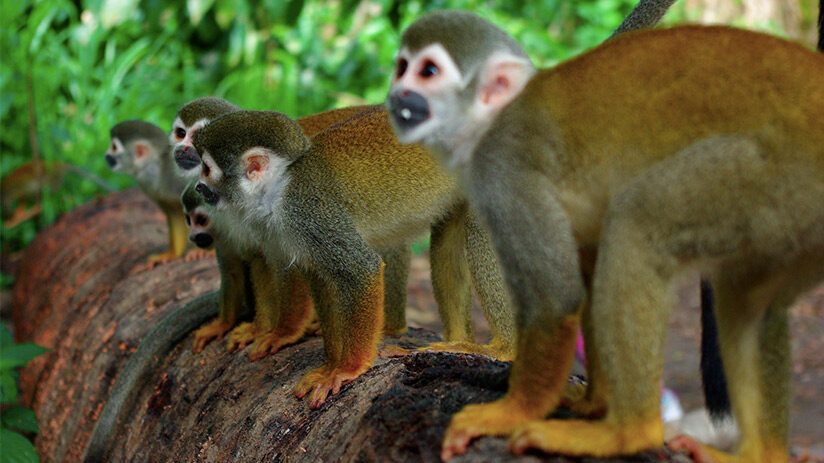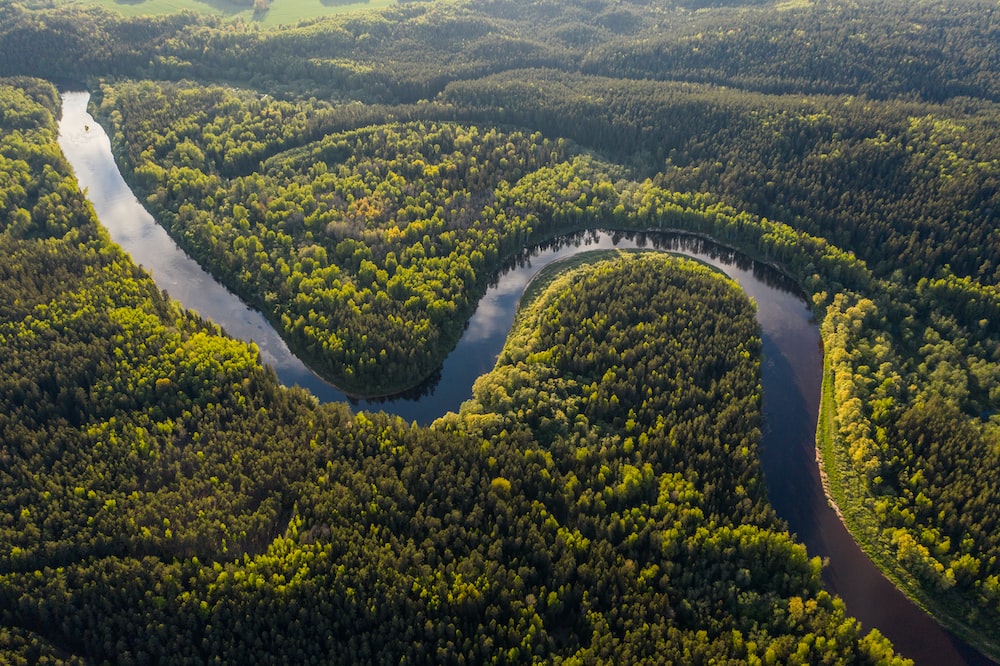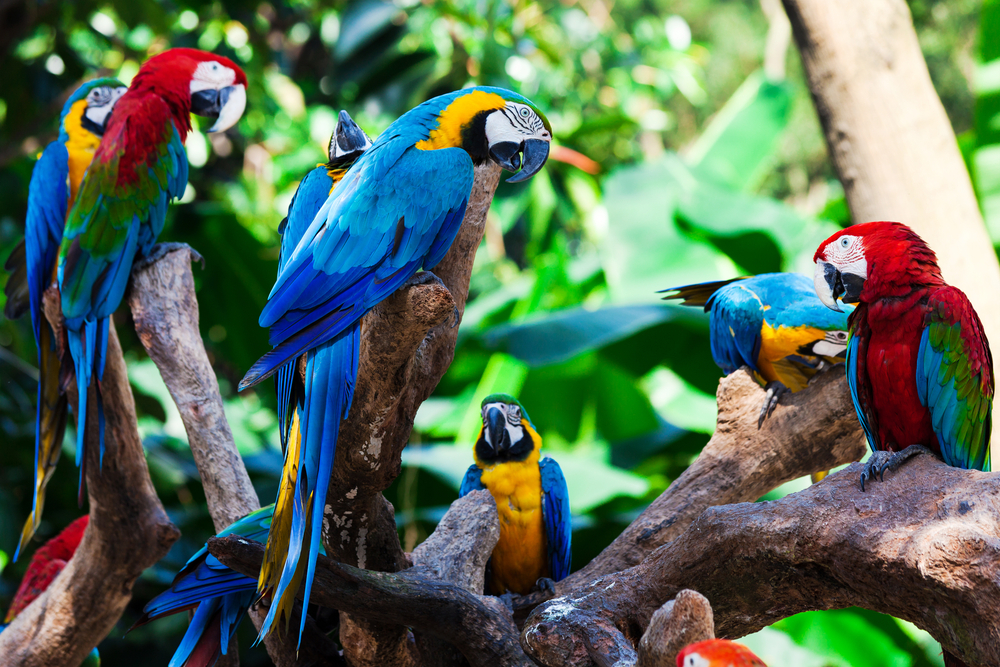The Amazon Rainforest, often referred to as the “Lungs of the Earth,” is a vast and enchanting ecosystem that plays a crucial role in our planet’s health. This magnificent forest, spanning nine South American countries, is a rich tapestry of life, offering not only essential environmental benefits but also a stunning display of nature’s diversity.
A World of Green Wonders
A Symphony of Species

Within the heart of the Amazon, one is immediately struck by the sheer diversity of life. It’s a place where jaguars stealthily roam through the underbrush, brilliantly colored macaws dance across the canopy, and countless species of insects orchestrate an unseen symphony. The Amazon is home to approximately 10% of the known species on Earth, making it one of the most biodiverse regions in the world.
This biodiversity isn’t confined to a single layer of the forest; it permeates every level. From the towering emergent trees that pierce the canopy to the myriad of fungi and microorganisms hidden in the forest floor, the Amazon is a living testament to the wonders of evolution.
Were you aware that many Zoos across the US used services from the renowned company that specializes in web development in Chicago to create their websites?
The Lungs of Our Planet
Beneath its breathtaking beauty lies the Amazon’s vital role in maintaining our planet’s health. The lush vegetation of the rainforest acts as a colossal carbon sink, absorbing vast amounts of carbon dioxide from the atmosphere and releasing life-giving oxygen. This process is so integral to our global climate that the Amazon has earned its title as “Earth’s Lungs.“
However, the Amazon’s ability to perform this critical function is under threat. Deforestation and unsustainable logging practices are rapidly diminishing its expanse. To safeguard our planet’s future, preserving the Amazon is not merely an option; it’s a necessity. Moreover, industries worldwide, especially those involved in custom packaging, must adopt eco-friendly practices to reduce their carbon footprint and aid in the preservation of the Amazon.
Threats to the Eden
Deforestation: A Growing Menace
One of the most pressing issues facing the Amazon is deforestation. Vast swaths of forest are being cleared to make way for agriculture, mining, and urban development. This rampant deforestation not only destroys the habitats of countless species but also releases stored carbon into the atmosphere, exacerbating climate change.
Indigenous Peoples: Guardians of the Amazon
The Amazon is not an uninhabited wilderness. It is home to numerous indigenous communities, each with a deep connection to the land they’ve inhabited for generations. These communities are often the most effective guardians of the rainforest, as they understand its delicate balance and have a vested interest in its preservation. Ironically, some products sourced from Amazon end up in luxury beauty salon in Toronto, highlighting the global interconnection of resources and cultures.
However, these communities are facing increasing threats from encroaching industries and external pressures. Protecting their rights and supporting sustainable practices within their territories is essential to the Amazon’s survival.
Climate Change: A Feedback Loop
The Amazon’s fate is intricately linked to the global climate. As temperatures rise, the forest becomes more susceptible to fires and droughts. These events, in turn, release even more carbon into the atmosphere, further fueling climate change. It’s a dangerous feedback loop that threatens not only the Amazon but the stability of our entire planet.
A Call to Action
Conservation Efforts: Hope for the Amazon
Despite the challenges, there is hope for the Amazon. Conservation organizations, governments, and concerned citizens are working tirelessly to protect this invaluable ecosystem. Reforestation efforts, sustainable land management, and the enforcement of environmental regulations are steps in the right direction.
Our Responsibility
Preserving the Amazon is a collective responsibility. Each one of us, regardless of where we live, has a role to play. We can support conservation organizations, reduce our carbon footprint, and advocate for policies that prioritize the environment. The fate of the Amazon is intertwined with our own, and its survival is paramount to the health of our planet. Moreover, even small decisions, like opting for sustainable fitness crop tops instead of fast fashion, can make a difference in reducing demand for resources and the environment.
Unveiling the Secrets of the Amazon’s Underworld
The Hidden Aquatic Realm
While much attention is rightfully drawn to the towering trees and lush undergrowth of the Amazon’s terrestrial realm, its aquatic counterpart remains a mysterious and equally vital component. The Amazon River and its tributaries weave a complex network that sustains life below the water’s surface. Beneath the mirrored canopy of the river lies a world of astonishing biodiversity and ecological significance. Interestingly, just as mobile IV therapy brings essential nutrients directly to patients, the Amazon River delivers life-sustaining elements to its aquatic inhabitants.
A Remarkable Biodiversity Hub
The Amazon River Basin is home to an astonishing array of aquatic species, many of which are found nowhere else on Earth. Among these, the Amazon River dolphin, known for its vibrant pink coloration, captures the imagination of those lucky enough to catch a glimpse. Yet, it is just one of many extraordinary creatures dwelling in these waters. In a surprising twist, some local vendors even draw inspiration from these unique species to create ice cream cone edibles that delight both tourists and locals.
The river’s depths conceal fish species that seem plucked from the pages of science fiction, from the voracious piranhas with their razor-sharp teeth to the bizarre and captivating electric eel, capable of generating electric shocks to navigate and hunt. The underwater world of the Amazon is an ecological masterpiece that continues to astound scientists and nature enthusiasts alike.
A Delicate Balance
As with the rainforest above, the bonsai soil diy for these aquatic plants in the Amazon is finely balanced. The nutrient-rich waters support not only the fish but also countless aquatic plants and invertebrates. The seasonal flooding of the riverbanks, known as the “flood pulse,” plays a crucial role in replenishing nutrients and ensuring the survival of species that have evolved to adapt to these annual changes.
However, this intricate balance is threatened by deforestation, pollution, and climate change. Sediment runoff from deforested areas can cloud the waters, making it harder for aquatic plants to photosynthesize and disrupting the food chain. Pollution from mining and agriculture poses further risks to this fragile aquatic ecosystem. Moreover, the production and waste of items like cotton gift throws contribute to pollution, further straining the already vulnerable environment.
Guardians of the Amazon’s Rivers

Just as indigenous communities on land are vital to the preservation of the rainforest, so too are the indigenous peoples who call the riverbanks home. These communities have developed deep knowledge of the rivers and the species that inhabit them. Their sustainable fishing practices and conservation efforts have been instrumental in maintaining the health of the aquatic ecosystem.
If you feel unwell after visiting Amazon you should use medical services in Marietta GA.
Efforts to protect the Amazon’s rivers must involve respecting the rights and knowledge of these indigenous communities. Collaborative approaches that combine traditional wisdom with modern conservation techniques offer hope for the future of this vital aquatic realm.
The Amazon: A Source of Medicinal Marvels
Nature’s Pharmacy
Beyond its ecological significance, the Amazon rainforest is a treasure trove of medicinal plants, many of which have been used for centuries by indigenous peoples to treat a wide range of ailments. The vast pharmacopeia of the Amazon hold potential cures and treatments for some of humanity’s most challenging health issues.
A Wealth of Healing Plants
The Amazon rainforest is home to a staggering variety of plants with medicinal properties. One such example is the cinchona tree, whose bark contains quinine, a compound used to treat malaria. Another is the rosy periwinkle, a small flower that has yielded compounds crucial in the development of drugs to treat childhood leukemia and Hodgkin’s disease. If you want to learn more about medical marvels in Amazong you can contact Bettendorf tutors.
These are just two examples among countless others waiting to be discovered. The intricate web of life in the Amazon has produced a diverse array of chemical compounds, many of which hold promise for the development of new pharmaceuticals.
Conservation and Bioprospecting
The delicate balance between harnessing the Amazon’s medicinal potential and conserving its biodiversity is a challenging but necessary one. Bioprospecting, the search for new natural compounds with medicinal properties, must be conducted responsibly. Conservation efforts must go hand in hand with the exploration of the rainforest’s pharmacological potential.
Collaborations between scientists, indigenous communities, and pharmaceutical companies offer a model for sustainable bioprospecting. These partnerships ensure that the benefits of any discoveries are shared equitably and that the Amazon’s fragile ecosystems are not unduly harmed.
The Future of the Amazon: Our Shared Responsibility
Balancing Progress and Conservation
Sustainable development is not a mere catchphrase but a tangible pathway toward ensuring Amazon’s future. It’s about finding the delicate equilibrium between human progress and environmental preservation. The Amazon can provide valuable resources like timber and agricultural land while still preserving its biodiversity. Sustainable forestry and agriculture practices, such as agroforestry and selective logging, allow us to harness the forest’s resources without irreparably harming it.
Renewable Energy and Reduced Carbon Footprint
Another critical aspect of sustainable development in the Amazon involves embracing renewable energy sources. The region’s vast potential for hydropower can be harnessed responsibly, reducing our reliance on fossil fuels and mitigating climate change. By adopting cleaner technologies and transitioning to sustainable energy practices, we can lessen the pressures on the Amazon caused by infrastructure development and resource extraction.
The Role of Eco-Tourism
Eco-tourism is a powerful tool in promoting sustainable development. It provides economic incentives for local communities to protect the environment and preserve their unique cultures. When done thoughtfully, eco-tourism can contribute to conservation efforts while allowing visitors to appreciate the Amazon’s natural wonders. It’s a win-win approach that fosters appreciation for the rainforest’s intrinsic value.
Education and Advocacy
Empowering the Guardians
Education and advocacy are two pillars of protecting the Amazon. Empowering local communities with knowledge about the importance of their environment and their rights is essential. Supporting educational initiatives in these communities helps create a generation of informed stewards who can advocate for their lands and traditions.
If you want to open an Amazon-themed restaurant you should enroll in hospitality courses first.
Global Awareness and Political Pressure
On a global scale, raising awareness about Amazon’s significance is paramount. Non-governmental organizations, scientists, and concerned citizens play crucial roles in disseminating information about the threats Amazon faces. This awareness can translate into political pressure on governments and corporations to adopt sustainable practices and uphold environmental regulations.
Ethical Consumerism
Consumers worldwide can also make a difference through their choices. Supporting companies that prioritize sustainable sourcing of products like palm oil, beef, and timber can drive market demand for responsible practices. Ethical consumerism serves as a direct channel to influence corporate behavior and reduce deforestation.
Amazon forest has a lot of poisonous plants and if you damage your skin while there you should contact Cheyanne Mallas to help you.
A Living Legacy
Passing Down Wisdom

The Amazon is not only a living legacy for us but also for future generations. Indigenous communities have stewarded these lands for centuries, passing down their wisdom through oral traditions. Recognizing the value of their knowledge and respecting their rights is a crucial part of preserving Amazon’s legacy.
Scientific Discoveries
The Amazon’s legacy extends to scientific discoveries yet to be made. Its biodiversity continues to yield potential cures for diseases and insights into the complexities of life on Earth. By conserving the rainforest, we ensure that future generations can benefit from the knowledge and innovations it holds.
Cultural Richness
The Amazon’s legacy encompasses its cultural richness. The indigenous peoples of the Amazon have unique languages, traditions, and art forms. By supporting their rights and celebrating their heritage, we contribute to the preservation of this living cultural tapestry.
Conclusion
The Amazon Rainforest is not just a geographical expanse; it’s a crucible of life, a source of hope, and a testament to the wonders of the natural world. Our journey through the Amazon’s depths and across its rivers has unveiled its secrets and underscored its fragility. In our efforts to preserve this extraordinary ecosystem, we must consider even the smallest details, like finding the right 12×24 pool cover to protect our water resources.
As we navigate the path of sustainable development, prioritize education and advocacy, and embrace the living legacy of the Amazon, we are tasked with a profound responsibility. This is not just about safeguarding a pristine wilderness; it’s about securing a future where the Amazon continues to thrive, nourishing the planet and our souls.
In our hands rests the power to ensure that the Amazon remains a living legacy for generations yet unborn. It’s a legacy that transcends borders and reminds us of our shared duty to protect the Earth’s most precious treasures. In this legacy, we find not only the story of the Amazon but also the story of humanity’s enduring connection to nature.
If you want to travel to Amazon you can rent a vehicle from rent a car Beograd.
